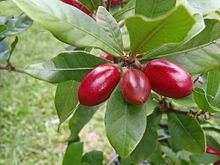Higher classification Synsepalum | Genus Synsepalum Conservation status Vulnerable Rank Species | |
 | ||
Similar Synsepalum, Jabuticaba, Sapotaceae, Purple mangosteen, Rambutan | ||
Miracle fruit synsepalum dulcificum
Synsepalum dulcificum is a plant known for its berry that, when eaten, causes sour foods (such as lemons and limes) subsequently consumed to taste sweet. This effect is due to miraculin. Common names for this species and its berry include miracle fruit, miracle berry, miraculous berry, sweet berry, and in West Africa, where the species originates, agbayun, taami, asaa, and ledidi.
Contents
The berry itself has a low sugar content and a mildly sweet tang. It contains a glycoprotein molecule, with some trailing carbohydrate chains, called miraculin. When the fleshy part of the fruit is eaten, this molecule binds to the tongue's taste buds, causing sour foods to taste sweet. At neutral pH, miraculin binds and blocks the receptors, but at low pH (resulting from ingestion of sour foods) miraculin binds proteins and becomes able to activate the sweet receptors, resulting in the perception of sweet taste. This effect lasts until the protein is washed away by saliva (up to about 30 minutes).
The names miracle fruit and miracle berry are shared by Gymnema sylvestre and Thaumatococcus daniellii, which are two other species of plant used to alter the perceived sweetness of foods.
History
The berry has been used in West Africa since at least the 18th century, when European explorer the Chevalier des Marchais provided an account of its use there. Marchais, who was searching West Africa for many different fruits in a 1725 excursion, noticed that local people picked the berry from shrubs and chewed it before meals. In the 1970s in the USA, an attempt was made to commercialize the fruit for its ability to turn unsweet foods into sweet foods without a caloric penalty, but ended in failure when the U.S. Food and Drug Administration (FDA) classified the berry as a food additive. There were controversial circumstances with accusations that the project was sabotaged and the research files stolen by the sugar industry to prevent loss of business caused by a drop in demand for sugar. However, the FDA has denied receiving any pressure from the sugar industry. Arguments similar to the ones used for this classification were used for the FDA's regulation on stevia now labeled as a "dietary supplement" instead of a "sweetener".
For a time in the 1970s, US dieters could purchase a pill form of miraculin. This phenomenon has enjoyed some revival in food-tasting events, referred to as "flavor-tripping parties" by some. The tasters consume sour and bitter foods, such as lemons, radishes, pickles, hot sauce, and beer, to experience the taste changes.
Characteristics
It is a shrub that grows between 1.8 and 4.5 meters (6 to 15 feet) in height and has dense foliage. Its leaves are 5–10 cm long, 2-3.7 cm wide and glabrous below. They are clustered at the ends of the branchlets. The flowers are white. It carries red, 2 cm long fruits. Each fruit contains one seed.
Cultivation
The plant grows best in soils with a pH as low as 4.5 to 5.8, in an environment free from frost and in partial shade with high humidity. It is tolerant of drought, full sunshine and slopes.
The seeds need 14 to 21 days to germinate. A spacing of 4 m between plants is suggested.
The plants first bear fruit after growing for approximately 3–4 years, and produce two crops per year, after the end of the rainy season. This evergreen plant produces small, red berries, while white flowers are produced for many months of the year.
The seeds are about the size of coffee beans.
In Africa, leaves are attacked by lepidopterous larvae, and fruits are infested with larvae of fruit-flies. The fungus Rigidoporus microporus has been found on this plant.
Transgenic tomato plants have been developed in research projects that produce miraculin.
Uses
In tropical West Africa, where this species originates, the fruit pulp is used to sweeten palm wine. Historically, it was also used to improve the flavor of soured cornbread.
Attempts have been made to create a commercial sweetener from the fruit, with an idea of developing this for patients with diabetes. Fruit cultivators also report a small demand from cancer patients, because the fruit allegedly counteracts a metallic taste in the mouth that may be one of the many side effects of chemotherapy. This claim has not been researched scientifically, though in late 2008, an oncologist at Mount Sinai Medical Center in Miami, Florida, began a study, and by March 2009, had filed an investigational new drug application with the U.S. Food and Drug Administration.
The berry is on the EU list of Novel Foods, and requires a safety assessment before it can be sold as food or used as a food additive.
In Japan, miracle fruit is popular among patients with diabetes and dieters.
The shelf life of the fresh fruit is only 2–3 days. Because miraculin is denatured by heating, the pulp must be preserved without heating for commercial use. Freeze-dried pulp is available in granules or in tablets, and has a shelf life of 10 to 18 months.
